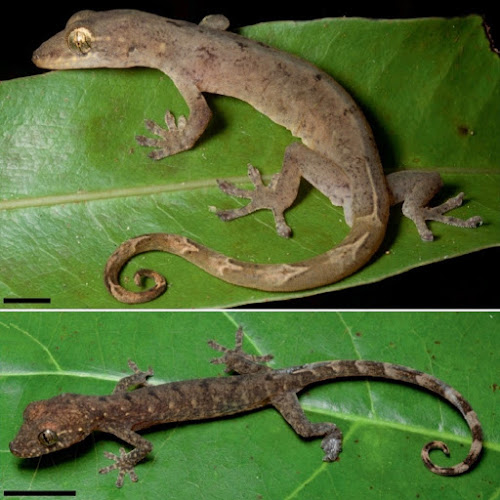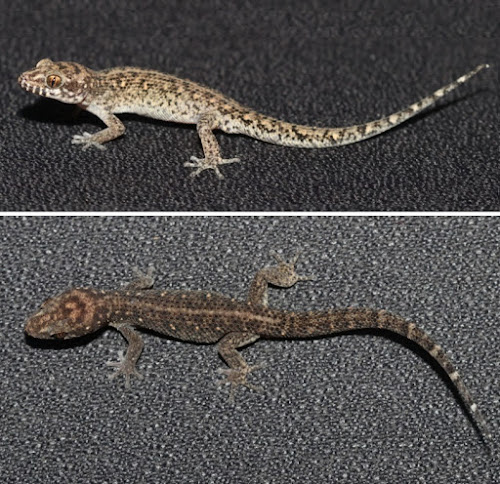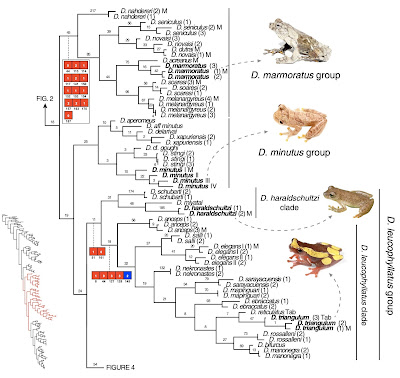[Most Recent Entries] [Calendar View]
Tuesday, September 15th, 2020
| Time | Event | ||||
| 3:34a | [Herpetology • 2020] Pseudogekko hungkag • Unexpected Discovery of Another New Species of Philippine False Gecko (Gekkonidae; Pseudogekko) from the Bicol Peninsula of Luzon Island
Abstract Philippine False Geckos (genus Pseudogekko) are secretive, delicate, slender-bodied, arboreal members of an obligate forest specialist clade that is substantially more species diverse than previously assumed. Over the last century, few species were added to this Philippine endemic genus. During the last decade, however, revisionary studies have resulted in the recognition of six new species. Several of these appear to be rare, have restricted geographic ranges, or exhibit patchy, fragmented areas of occurrence. In this study we report on the discovery of a second Luzon Island species in the P. brevipes complex, a clade in which members typically have diminutive bodies. Although the new species is readily diagnosed from all congeners, we estimated its systematic affinities with a phylogenetic analysis of DNA sequence data and confirm that it is nested within the P. brevipes clade. The new species constitutes an exception to the general appearance of other members of the P. brevipes complex, in that it has a relatively heavy-bodied, robust stature, separating it phenotypically from all members of the group. Our new species constitutes the second Luzon lineage in this group of rainforest species (considered previously to be restricted to the Negros-Panay and Mindanao Pleistocene aggregate island complexes [PAICs] in the central and southern landmasses of the archipelago). Given the lack of available biodiversity information for the major remaining forests of the Bicol Peninsula, which necessarily come from targeted faunal surveys, the new species' conservation status cannot yet be assessed. In light of the highly fragmented nature of forested habitats of southern Luzon, we suspect the new species might be vulnerable to extinction as a result of habitat loss. Pseudogekko hungkag sp. nov. Rafe M. Brown, Camila G. Meneses, Perry L. Wood Jr., Jason B. Fernandez, Michael A. Cuesta, Michael A. Clores, Claire Tracy, Matthew D. Buehler and Cameron D. Siler. 2020. Unexpected Discovery of Another New Species of Philippine False Gecko (Gekkonidae; Pseudogekko) from the Bicol Peninsula of Luzon Island. Herpetologica. 76(3); 315-329. DOI: 10.1655/Herpetologica-D-19-00029.1 | ||||
| 6:56a | [Herpetology • 2020] Dixonius dulayaphitakorum จิ้งจกดินระนอง • A New Leaf-toed Gecko (Gekkonidae: Dixonius) from the City of Ranong, southwestern Thailand
Abstract We describe Dixonius dulayaphitakorum sp. nov. from Ranong city, Ranong Province, southern peninsular Thailand. The new, ground-dwelling species differs from all currently recognized Dixonius by a combination of morphological characters and pattern: maximal known SVL of 47.8 mm, 22 longitudinal rows of dorsal tubercles; 33 to 35 paravertebral scales; 22 longitudinal rows of ventrals across the abdomen; six or seven precloacal pores in males, no pores in females; no distinct canthal stripe; and a spotted dorsal pattern. Based on dorsal pattern, the new species seems related to Dixonius siamensis. This description brings to 11 the number of Dixonius species, and to five the ones endemic to Thailand. Keywords: Gekkonidae, Gekkota, Thai-Malay Peninsula, Dixonius dulayaphitakorum sp. nov.
Dixonius dulayaphitakorum sp. nov. Etymology. The specific epithet is a mark of friendship honoring Mr. Santisak and Mrs. Boonneam Dulayaphitak for their support to the herpetological field work of the first author, and who often drew his attention on interesting specimens. We suggest the following common names: Djing-djok din Ranong - จิ้งจกดินระนอง (Thai), Ranong Leaf-toed Gecko (English), Dixonius de Ranong (French), Ranong-Blattfingergecko (German). Montri Sumontha and Olivier S.G. Pauwels. 2020. A New Leaf-toed Gecko (Gekkonidae: Dixonius) from the City of Ranong, southwestern Thailand. Zootaxa. 4852(2); 166–176. DOI: 10.11646/zootaxa.4852.2.2 | ||||
| 9:08a | [Herpetology • 2020] The Phylogeny of Dendropsophini (Anura: Hylidae: Hylinae)
Abstract The relationships of the hyline tribe Dendropsophini remain poorly studied, with most published analyses dealing with few of the species groups of Dendropsophus. In order to test the monophyly of Dendropsophini, its genera, and the species groups currently recognized in Dendropsophus, we performed a total evidence phylogenetic analysis. The molecular dataset included sequences of three mitochondrial and five nuclear genes from 210 terminals, including 12 outgroup species, the two species of Xenohyla, and 93 of the 108 recognized species of Dendropsophus. The phenomic dataset includes 46 terminals, one per species (34 Dendropsophus, one Xenohyla, and 11 outgroup species). Our results corroborate the monophyly of Dendropsophini and the reciprocal monophyly of Dendropsophus and Xenohyla. Some species groups of Dendropsophus are paraphyletic (the D. microcephalus, D. minimus, and D. parviceps groups, and the D. rubicundulus clade). On the basis of our results, we recognize nine species groups; for three of them (D. leucophyllatus, D. microcephalus, and D. parviceps groups) we recognize some nominal clades to highlight specific morphology or relationships and facilitate species taxonomy. We further discuss the evolution of oviposition site selection, where our results show multiple instances of independent evolution of terrestrial egg clutches during the evolutionary history of Dendropsophus. Victor G.D. Orrico, Taran Grant, Julian Faivovich, Mauricio Rivera‐Correa, Marco A. Rada, Mariana L. Lyra, Carla S. Cassini, Paula H. Valdujo, Walter E. Schargel, Denis J. Machado, Ward C. Wheeler, Cesar Barrio‐Amorós, Daniel Loebmann, Jiří Moravec, Juliana Zina, Mirco Solé, Marcelo J. Sturaro, Pedro L.V. Peloso, Pablo Suarez and Célio F.B. Haddad. 2020. The Phylogeny of Dendropsophini (Anura: Hylidae: Hylinae). Cladistics. DOI: 10.1111/cla.12429 |
| << Previous Day |
2020/09/15 [Calendar] |
Next Day >> |














